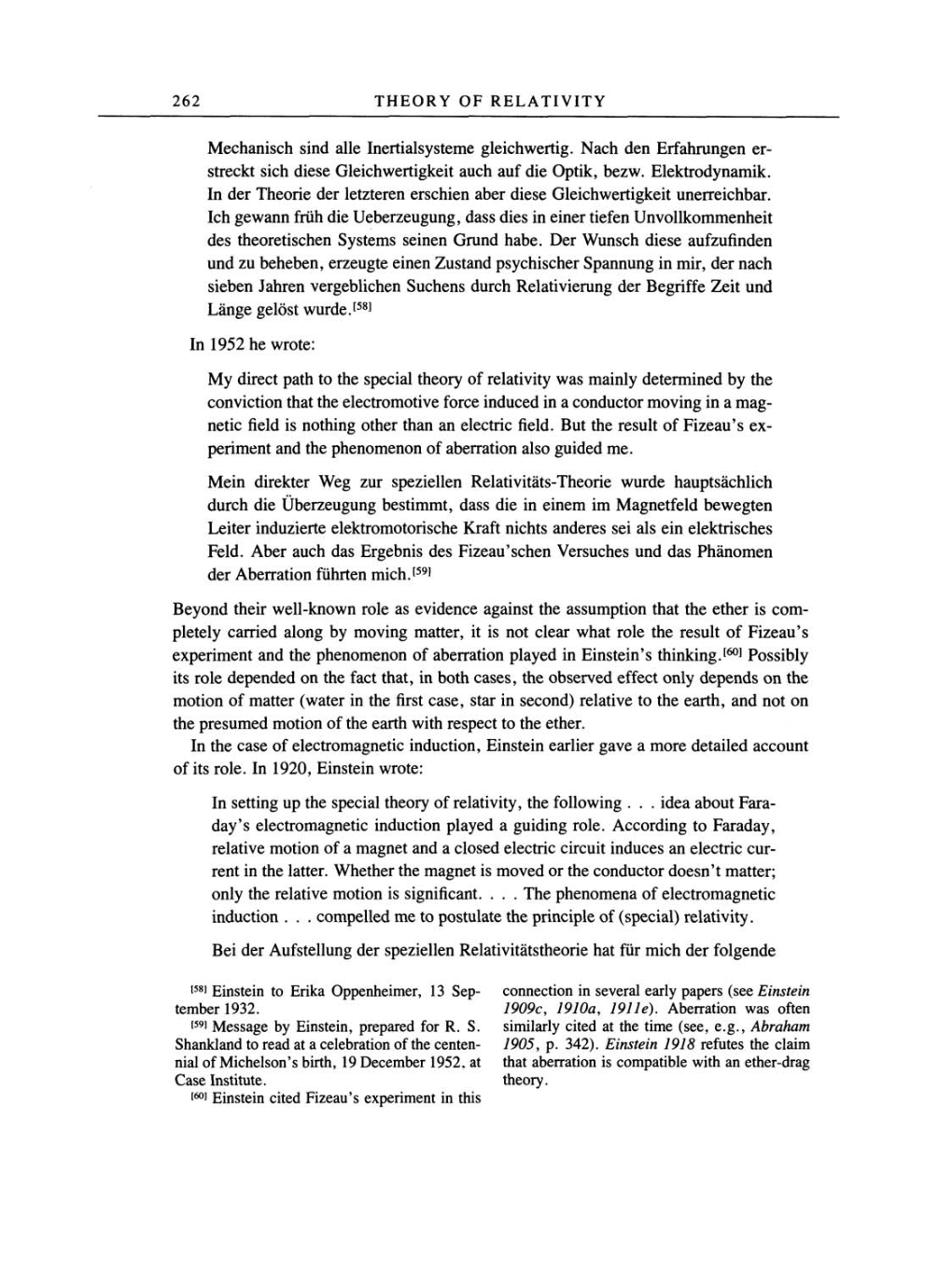262 THEORY
OF RELATIVITY
Mechanisch sind alle
Inertialsysteme gleichwertig.
Nach den
Erfahrungen er-
streckt sich diese
Gleichwertigkeit
auch
auf
die
Optik,
bezw.
Elektrodynamik.
In
der
Theorie der letzteren erschien aber diese
Gleichwertigkeit
unerreichbar.
Ich
gewann
früh die
Ueberzeugung,
dass dies in einer tiefen
Unvollkommenheit
des theoretischen
Systems
seinen Grund habe. Der Wunsch diese aufzufinden
und
zu
beheben,
erzeugte
einen Zustand
psychischer Spannung
in
mir,
der
nach
sieben Jahren
vergeblichen
Suchens durch
Relativierung
der
Begriffe
Zeit
und
Länge gelöst
wurde.[58]
In 1952 he wrote:
My
direct
path
to the
special theory
of
relativity was mainly
determined
by
the
conviction
that the electromotive force induced in
a
conductor
moving
in
a mag-
netic field
is
nothing
other than
an
electric field. But the result
of Fizeau's
ex-
periment
and the
phenomenon
of
aberration also
guided me.
Mein
direkter
Weg zur speziellen
Relativitäts-Theorie wurde
hauptsächlich
durch die
Uberzeugung
bestimmt,
dass die in einem im
Magnetfeld
bewegten
Leiter
induzierte elektromotorische Kraft nichts anderes sei als
ein elektrisches
Feld. Aber auch
das
Ergebnis
des Fizeau'schen
Versuches
und
das
Phänomen
der Aberration führten
mich.[59]
Beyond
their
well-known role
as
evidence
against
the
assumption
that
the
ether
is
com-
pletely
carried
along by moving
matter,
it
is
not
clear
what role the
result of Fizeau's
experiment
and the
phenomenon
of
aberration
played
in
Einstein's
thinking.[60]
Possibly
its role
depended
on
the fact that, in both
cases,
the observed
effect
only
depends
on
the
motion
of
matter
(water
in
the first
case,
star in
second)
relative to the earth, and not
on
the
presumed
motion
of
the earth with
respect
to the ether.
In the
case
of
electromagnetic
induction, Einstein earlier
gave
a more
detailed
account
of
its role.
In
1920,
Einstein wrote:
In
setting up
the
special theory
of
relativity,
the
following
...
idea about Fara-
day's
electromagnetic
induction
played a guiding
role.
According
to
Faraday,
relative motion
of
a magnet
and
a
closed electric circuit induces
an
electric
cur-
rent
in
the latter. Whether
the
magnet
is moved
or
the
conductor doesn't
matter;
only
the relative motion
is
significant....
The
phenomena
of
electromagnetic
induction
...
compelled
me
to
postulate
the
principle
of
(special)
relativity.
Bei
der
Aufstellung
der
speziellen
Relativitätstheorie
hat für
mich
der
folgende
[58]
Einstein to Erika
Oppenheimer,
13
Sep-
tember 1932.
[59] Message
by
Einstein,
prepared
for R.
S.
Shankland to read at
a
celebration
of
the centen-
nial
of Michelson's
birth, 19
December 1952,
at
Case Institute.
[60]
Einstein cited
Fizeau's
experiment
in this
connection in several
early papers
(see
Einstein
1909c,
1910a, 1911e). Aberration
was
often
similarly
cited at the time
(see,
e.g.,
Abraham
1905,
p.
342).
Einstein 1918 refutes
the claim
that aberration is
compatible
with
an
ether-drag
theory.
